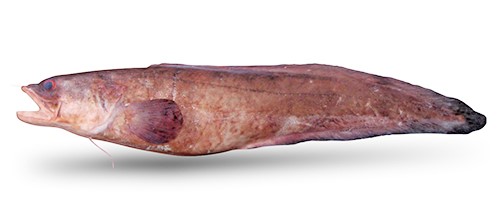
The appearance of Kingklip (Minamiakahige)
Common name: Kingklip, Pink cusk-eel, Ling, Northern ling, Pink ling, Rock ling, Common ling, Banded ling, Australian rockling
Japanese name: Minamiakahige (ミナミアカヒゲ)
French common name: Abadèche rose, Abadèche rosé, Abadèche rosée, Lingue
German common name: Leng
Italian common name: Molva
Spanish common name: Abadejo, Bacalao del sur, Congribadejo rosado, Congribadejo rosé, Congrio colorado, Congrio dorado, Dorado, Maruca, Pink cusk-eel, Rosada
Portuguese common name: Congro, Congro-rosa, Côngrio róseo, Maruca-da-Argentina, Róseo
Russian common name: Конгрио черный
Scientific name: Genypterus blacodes (Forster, 1801)
Nigiri sushi detail: Kingklip (Minamiakahige) Nigiri sushi
Characteristics:
Kingklip (Minamiakahige) is distributed in Mozambique, South Africa, Argentina, New Zealand, and Australia. The body color is orange-pink and brown with irregular patterns on the back, and the abdomen is white. Its total length ranges from 80 to 120 cm. It reaches a maximum length of 2 meters. It lives from the surface to a depth of 1,000 meters.
Minamiakahige is closely related to cod, and its white flesh is moderately fatty, making it a substitute for high-end fish in Japan. Unlike its grotesque appearance, its fine, non-toxic flesh is very tasty fried, meuniere, pot dish, saikyo-yaki, smoked, and so on. It is popular in its producing regions as the finest white fish, and is in high demand in the U.S. and Europe. Smaller fish are processed into fish paste and exported to Japan as an ingredient in kamaboko.
In the past, many Japanese fishing boats caught Kingklip off the coast of South Africa and distributed them in the Japanese market under the name Horsehead (Amadai). However, when the 200-nautical mile Exclusive Economic Zone (EEZ) was established in 1977, Japanese fishing vessels were closed off from South African waters, and Kingklip became hard to obtain. In New Zealand and Australia, kingklip is simply called ling, which originally referred to a type of European cod.
Share this article